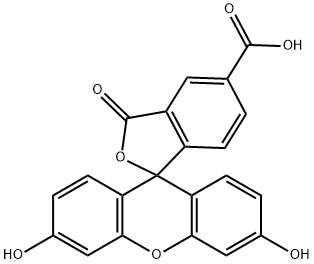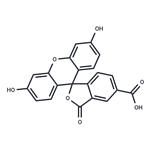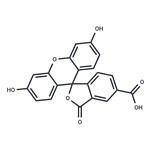5-Carboxyfluorescein is a mixture of 5- and 6-isomers prepared by the reaction of benzotricarboxylic anhydride with resorcinol and zinc chloride.
Reaction: 1,2,4-Benzenetricarboxylic anhydride (also called 4-carboxyphthalic anhydride, 25.0 g, 0.13 mol) was added to a solution of 1,3-dihydroxybenzene (also called resorcinol, 28.6 g, 0.26 mol) in methane sulfonic acid (1M). An air condenser was attached to the flask and the reaction was heated at 85°C in an open vessel for 24 h. After cooling to room temperature, the reaction mixture was poured into 7 volumes of ice/water. An orange-yellow precipitate formed; this was collected by filtration and dried in an oven at 200°C. This residue was recrystallized two times from methanol/hexane to give 1.0 g of 6-carboxyfluorescein methanesulfonic acid adduct 2b. The mother liquors from this procedure were collected, the solvent was removed in vacuo, and the residues were recrystallized two times from ethanol/hexanes to give 3.2 g of 5-carboxyfluorescein methanesulfonic acid adduct 2a.

The methane sulfonic esters 2 are easily converted to the 5- and 6-carboxyfluoresceins 1 by treatment with sodium hydroxide solution then neutralizing with aqueous HCl.




